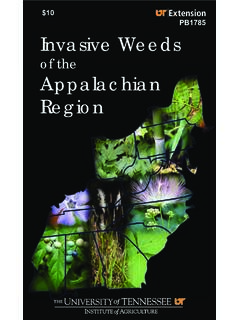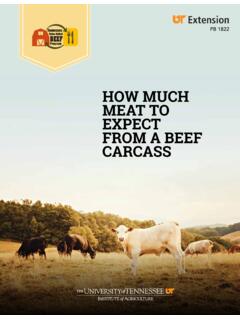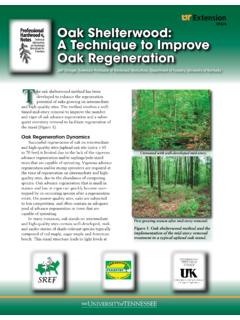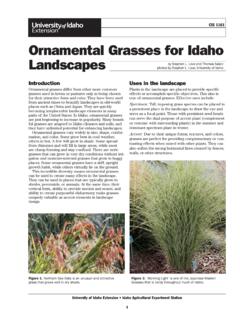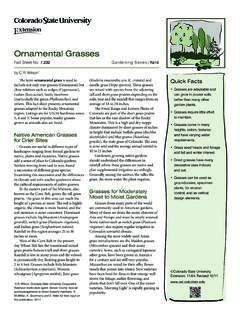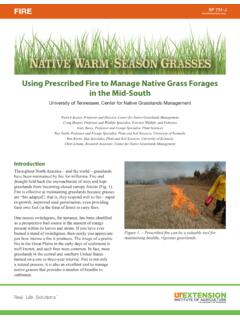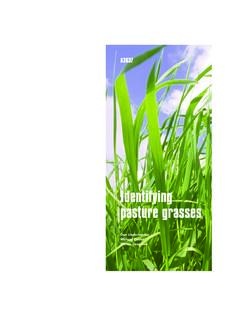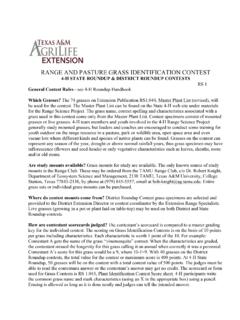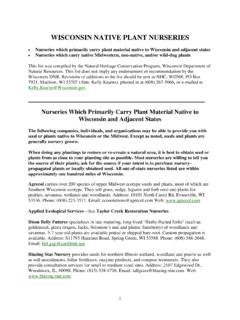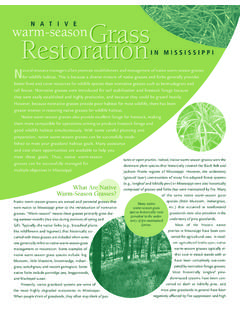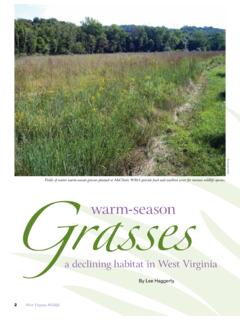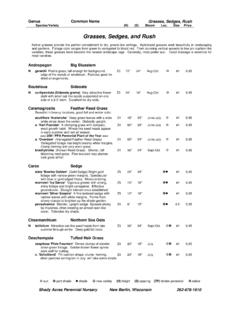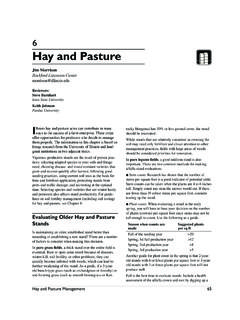Transcription of Native Warm-Season Grasses for Mid-South Forage Production
1 1 University of Tennessee, Center for Native Grasslands ManagementNative Warm-Season Grasses for Mid-South Forage ProductionIntroductionWhat Are Native Warm-Season Grasses ? Native Warm-Season Grasses (NWSG) are a group of tall-growing bunch Grasses that offer the potential for excellent Forage Production across the Mid-South . They have a number of key attributes that make them of interest to Forage growers in the to the Mid-South These Grasses have grown in the Mid-South since before human settlement. Native Warm-Season Grasses were grazed by buffalo and elk for thousands of years and then, during the first two centuries of European settlement, by free-ranging domestic livestock.
2 Native Grasses are naturally well-adapted to the region s soils, climate and pests (insects and diseases). Vigorous Summer Growth Peak growth of these Grasses occurs during summer. They break dormancy in late March and early April and then grow rapidly from mid-May through midsummer. In late summer, growth slows until fall dormancy, usually in October. The maturity dates of the various species vary somewhat, but all follow this pattern. They remain dormant through Key Species While there are many species of Grasses Native to the Mid-South , this publication will focus on five species that are important for Forage Production : big bluestem, little bluestem, indiangrass, switchgrass and eastern I Plant NWSG?
3 Native Warm-Season Grasses , like any Forage option, have advantages and disadvantages. The most important are described below. Advantages of NWSG Filling the Summer Forage Gap Because NWSG grow during the summer months, they readily complement existing cool-season Forage Production (Fig. 1). Tall fescue, the major Forage grown in the Mid-South , becomes semi-dormant during summer, especially when prolonged droughts occur. A good source of high-quality Forage during the summer can make a strong contribution to the profitability and success of Forage and cattle 731-APatrick Keyser, Professor and Director, Center for Native Grasslands ManagementCraig Harper, Professor and Wildlife Specialist, Forestry, Wildlife and Fisheries Gary Bates, Professor and Forage Specialist, Plant SciencesJohn Waller, Professor Emeritus, Animal Science Elizabeth Doxon Holcomb, Research Associate, Center for Native Grasslands Management2 Perennial Grasses The five NWSG described here are perennials that can last 15 20 years or longer with proper management (Fig.)
4 2). As with any perennial, NWSG provide considerable annual savings in seed, fertilizer, herbicides and time when compared to Warm-Season annuals (see UT Extension publication Economic Implications of Growing Native Warm-Season Grasses for Forage in the Mid-South , SP 731-E, for more information). Perennial Forage crops also help producers avoid the risk of establishment failure each summer inherent with Adapted The Grasses described here are Native to the Mid-South , but also are found throughout much of eastern North America. For example, switchgrass occurs from southern Canada to northern Mexico, east to the Atlantic Coast. Within that vast range, NWSG can grow well on sites that vary from poor, ridge-top soils to poorly drained bottoms.
5 These adaptations vary among the five species. As long as the proper variety and species are selected, NWSG can be grown on most sites in the Mid-South where you might want to produce forages. JFMAMJJASOND cool-seasongrasswarm-seasongrassProducti onFig. 1. Warm-Season Grasses , those that put on most of their growth during the summer, can be an excellent complement to cool-season Grasses that primarily grow in the spring and fall. Having both types of forages can eliminate the summer Forage slump. Exceptional Drought Tolerance There are two major reasons NWSG are particularly drought-tolerant. First, like many Warm-Season species, they have a metabolic pathway that is very efficient in water use.
6 This pathway is referred to as C-4 and is in contrast to that of cool-season Grasses , which have a C-3 metabolic pathway. The second major reason NWSG are drought-tolerant is they produce exceptionally deep root systems, up to 12 feet in many cases. One large-scale, 10-year study documented no relationship between first cutting yield (June) of switchgrass and spring rainfall (April - June). In a West Tennessee study conducted during a record-breaking drought year (2007), switchgrass still yielded an impressive tons/ac of biomass. NWSG are the most drought-tolerant forages we can grow in the Fertilizer Inputs Because they are naturally adapted to the region s soils, NWSG can be productive even where fertility is not high.
7 Most research indicates there are not substantial improvements in yield above about 90 lb of N per acre and there is not a consistent yield response to P and K amendments. Furthermore, as long as pH exceeds , there does not appear to be any need for Have They Gone?The simple answer is nowhere they are still here. You can find Native Grasses growing along roadsides, railroad and power line rights-of-way, and other out-of-the-way places. But where forests have grown-up, they were shaded-out. Where ground was plowed, they are gone. And where fences were built and year-round grazing was practiced, they disappeared cattle preferentially graze these species and they can be eliminated where grazing pressure is not t This Just Broomsedge?
8 Broomsedge, a species also Native to the region, is closely related to the other NWSG and shares their growth habit, growth season, drought tolerance and ability to grow well in poor soils. However, the five species of NWSG we are focusing on produce more Forage and are far more palatable to cattle than broomsedge. 3 High Yields Depending on species, site quality and available moisture, NWSG can yield 4 5 tons of Forage per acre when harvested for hay (see Producing Hay from Native Warm-Season Grasses in the Mid-South , SP 731-D, for more information). In a grazing setting, stocking rates can be approximately 1,400 2,000 lb per acre, depending on species, under full-season summer grazing (see Grazing Native Warm-Season Grasses in the Mid-South , SP 731-C, for more information).
9 High-Quality Forage As with any Forage , hay quality is strongly influenced by timing of harvest. Harvest of NWSG at late-boot stage will typically produce hay with protein levels of 10 percent or higher. However, like most Warm-Season forages, NWSG will test at levels below those for cool-season forages harvested at a comparable maturity level. This is partly because proteins in NWSG do not break down as quickly during ruminant digestion and bypass the rumen; thus, they are referred to as bypass proteins. Because bypass proteins can be absorbed in the intestines, animal performance on NWSG exceeds what we would predict based on Forage sample analysis.
10 For example, when grazed, NWSG routinely produce from lb of daily gain in steers (Fig. 3). Furthermore, NWSG Forage quality is not diminished by endophyte fungi, a substantial problem with tall Because NWSG are adapted to the soils and climate of our region and are late-successional species that do not spread quickly, they are not invasive. Even after many years, Native Grasses will remain where they were originally planted. Few Pests Because these Grasses are Native to the Mid-South , they have few important pests. At this time, the only pest known to be a problem for NWSG is leaf rust, which is observed on Friendly Many species of wildlife, such as eastern cottontail and northern bobwhite, thrive in Native Grasses .

